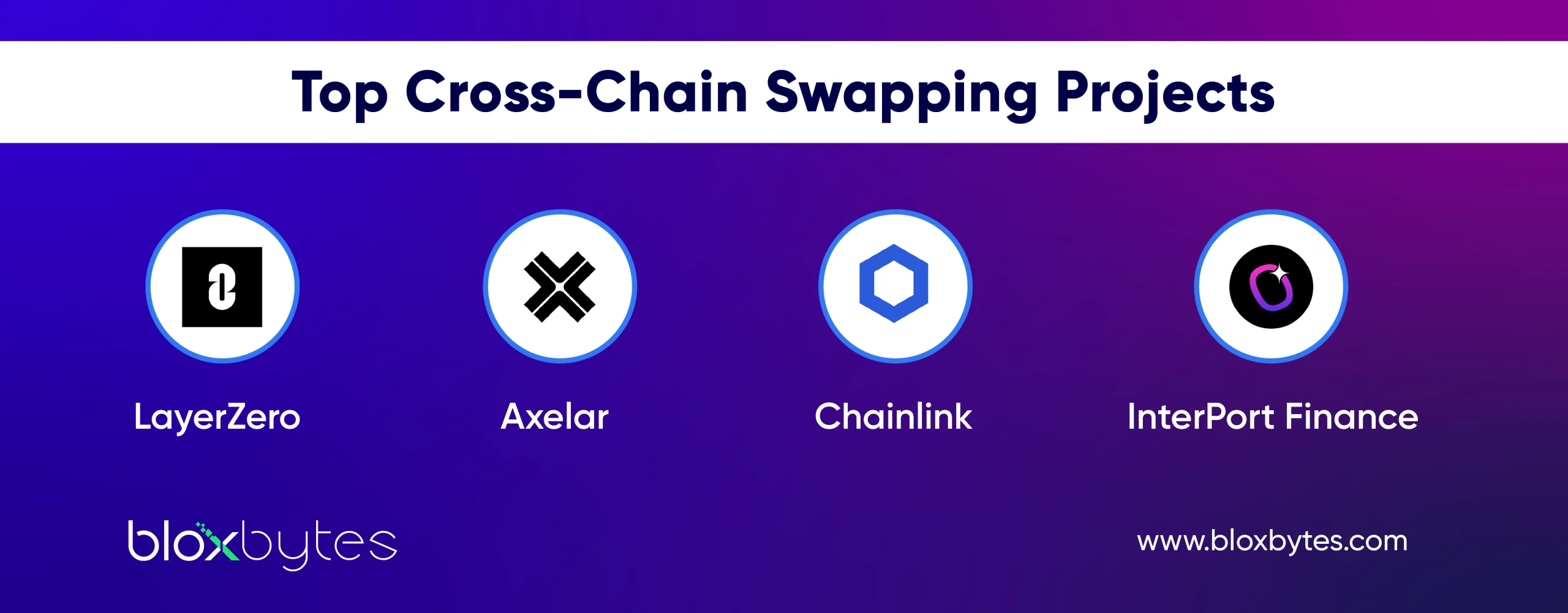
Introduction
Web3 & Blockchain Consultancy :
Building the Future of Interconnected Blockchains with Cross Chain Swaps
One of the most significant advancements in the domain of blockchain technology is the development of cross-chain swaps, as they facilitate the transfer of assets between disparate blockchain networks. This advancement not only improves the functionality and usability of cryptocurrencies but also opens a range of possibilities for investors, traders, and developers. Cross-chain swaps are essential as they tackle a significant challenge in the blockchain world: the isolation of assets and information within distinct blockchain ecosystems. With the growing number of blockchain platforms, enabling interoperability between different networks is increasingly crucial.Key Takeaways
- Cross-Chain Swaps: Cross-chain swaps enable the seamless exchange of digital assets across different blockchain networks, enhancing blockchain interoperability.
- Technological Foundations: Key technologies like Atomic Swaps, Hash Time-Locked Contracts (HTLCs), and bridge protocols facilitate secure and efficient cross-chain transactions.
- Impact on Blockchain Ecosystem: Cross-chain swaps broaden the scope of blockchain applications, including DeFi, NFTs, and dApps, by allowing users to interact across multiple blockchain networks without restrictions.
- Challenges and Innovations: While cross-chain swaps offer numerous benefits such as increased liquidity and flexibility, they also face challenges like technical complexity, scalability issues, and security concerns.
- Future Potential: The continuous development in cross-chain technology promises enhanced interoperability, greater efficiency, and a more interconnected digital asset ecosystem.
What are Cross Chain Swaps?
Cross-chain swaps are a groundbreaking innovation in the blockchain realm, designed to allow seamless asset transfers between diverse blockchain networks. These swaps address a pivotal issue in the blockchain community: the challenge of interoperability.The Need for Cross-Chain Swaps
Blockchain networks typically operate independently, confined within their own ecosystems. This isolation limits the movement of assets, information, and value between chains. Cross-chain swaps provide a solution by facilitating the smooth transfer of assets between these separate networks, thereby improving the overall utility and reach of blockchain technology.Impact on the Blockchain Ecosystem
Cross-chain swaps expand the capabilities of blockchain technology by enabling transactions across various blockchains. This allows users to interact with multiple networks, liberating them from the constraints of any single blockchain’s features or resources. Such developments are particularly significant for the growth of decentralized finance (DeFi), non-fungible tokens (NFTs), and a wider range of decentralized applications (dApps).How Do Cross Chain Swaps Work?
Cross-chain swaps represent a next-generation framework that utilizes multiple technological elements and processes to enable secure and effective transactions across different blockchain networks.Understanding the Technical Foundations
Let’s explore the technical foundations of cross-chain swaps to have a better understanding of its workings.Smart Contracts
Central to cross-chain swaps are smart contracts—contracts that execute themselves according to the agreement’s code. These contracts function independently of intermediaries, enhancing trust and security in transactions.Hash Time-Locked Contracts (HTLCs)
Essential to many cross-chain swaps, HTLCs introduce a time-sensitive element to transactions. They require the transaction recipient to confirm receipt within a specified timeframe by producing a cryptographic proof of payment. If the recipient does not verify the transaction in time, the funds revert to the sender. This mechanism is crucial in atomic swaps.The Mechanics of Cross Chain Swaps
Cross-chain swaps allow for the exchange of cryptocurrencies across different blockchains without the need for a trusted third party. This is primarily achieved through various techniques.Atomic Swaps
This process involves two parties who agree to exchange tokens across different blockchains. Through HTLCs, atomic swaps ensure that both parties either complete the exchange successfully or not at all, hence the name ‘atomic’. This technique mitigates the risk of one party defaulting but requires that both blockchains utilize compatible cryptographic hash functions.Bridge Protocols
Serving as intermediaries, bridge protocols link two distinct blockchains. They typically use a “lock-and-mint” or “burn-and-mint” strategy, where tokens are either secured in a smart contract on the original chain and minted on the target chain or destroyed on the original and reissued on the destination chain. This mechanism supports the movement of assets between blockchain solutions, enhancing the versatility and accessibility of digital assets.Advanced Implementations and Innovations
Let’s explore the advanced implementations and innovations that are pushing the boundaries of cross chain swap technology.Decentralized Oracle Networks
Projects like Chainlink are pushing the boundaries of cross-chain swap technology through decentralized Oracle networks. These networks provide secure, tamper-proof data for complex smart contracts across any blockchain, improving the efficiency and security of cross-chain swaps.Liquidity Pools and DEXs
Decentralized exchanges (DEXs) and liquidity pools play a crucial role in cross-chain swaps. They offer the liquidity needed for trading assets, enabling smooth swaps without traditional market makers.LayerZero and Related Technologies
Solutions such as LayerZero provide capabilities beyond simple asset transfers, enabling the transmission of complex messages across blockchains. This technology allows for more sophisticated interactions, like the execution of smart contract commands on different blockchains, thus expanding the functionalities of cross-chain swaps.Cross-Chain Swap Systems
Cross-chain swaps are crucial for enhancing interoperability within the blockchain domain, employing a variety of systems, each with its unique mechanisms and features.Atomic Swaps
Atomic swaps enable two participants to exchange tokens across different blockchains using Hash Time-Locked Contracts (HTLCs). These contracts require mutual confirmation of fund receipt within a designated timeframe, ensuring that transactions are either executed simultaneously or nullified.
Pros |
Cons |
| Decentralization: Eliminates the need for intermediaries, preserving blockchain’s decentralized nature. | Complexity: Requires significant technical knowledge to initiate and manage. |
| Security: HTLCs ensure complete transaction execution or total reversal, reducing the risk of partial asset loss. | Limited Scalability: Difficulties arise in pairing parties and assets across various chains. |
| Privacy: Direct transactions between parties enhance privacy, offering an advantage over centralized platforms. | Compatibility Issues: Necessitates compatible scripting and hash algorithms on all involved blockchains. |
Bridge Protocols
These protocols establish a link between two blockchains, allowing tokens to be ‘locked’ on one and ‘minted’ as equivalent tokens on another, thereby facilitating the asset swap.
Pros |
Cons |
| Broad Accessibility: Supports numerous tokens and blockchain types. | Centralization Risk: Some bridges introduce centralized control points, which conflict with the decentralization ethos of blockchain. |
| Liquidity: Connects disparate blockchain ecosystems, improving liquidity. | Security Vulnerabilities: Bridges can be targets for attacks, posing risks to user funds. |
| User Experience: Generally more user-friendly than atomic swaps. | Dependency on External Infrastructure: This relies on the bridge’s stability and security for continuous asset protection. |
LayerZero’s Omnichain Interoperability Protocol
LayerZero provides a framework for seamless cross-chain communication, employing an omnichain strategy to facilitate interactions across multiple blockchains.| Pros | Cons |
| Interoperability: Enables extensive blockchain connectivity, enhancing ecosystem integration. | Complex Technology: The complex underlying technology may deter less tech-savvy users. |
| Efficiency: Simplifies cross-chain transactions, improving overall user experience. | Network Dependency: Its performance and security heavily depend on the stability of the base network. |
| Scalability: Designed to accommodate growing transaction volumes, making it suitable for broader adoption. | Emerging Technology Risks: As a relatively new technology, it might face unexpected challenges or limitations. |
Cross-Chain DEX Aggregators
These platforms consolidate liquidity from various decentralized exchanges (DEXs) across multiple blockchains, ensuring efficient token swaps at optimal rates.
Pros |
Cons |
| Optimized Trading: Provides the best trading rates by pooling liquidity from several sources. | Smart Contract Risks: Relies on the security of underlying contracts from various platforms. |
| Decentralization: Upholds the decentralized ethos by leveraging numerous decentralized liquidity sources. | Complex Pricing: The aggregation process can complicate price determination and order execution. |
| Wide Asset Range: Offers access to a vast selection of tokens across different blockchains. | Slippage Potential: Larger trades might experience price slippage due to split liquidity. |
Top Cross-Chain Swapping Projects
The blockchain ecosystem is experiencing a surge in cross-chain swapping projects, each addressing interoperability challenges with unique solutions. Here are some of the leading projects setting new benchmarks in this space: